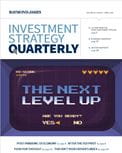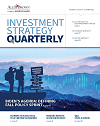Analyzing the U.S. economy post-pandemic
Chief Economist Eugenio Alemán and Economist Giampiero Fuentes note that while they expect economic growth to slow, they do not foresee a recession in 2024.
To read the full article, see the Investment Strategy Quarterly publication linked below.
We are normally reluctant to use trendy phrases to explain either our good and/or bad calls regarding the U.S. economy. However, saying that ‘this time is different’ is more than fitting today to understand what has happened to the U.S. economy since the recovery from the COVID-19 pandemic. U.S. economic growth surprised friends and foes during 2023 as both the post-pandemic normalization process continued and the Federal Reserve’s (Fed) attempt to bring down the surge in inflation contributed to the asynchronous performance of the U.S. economy.
During a typical economic cycle, as the economy hits the peak of the cycle, the Fed increases interest rates to slow economic activity to avoid inflation becoming a problem down the road. That is, at the peak of the cycle, resources are fully utilized and thus any further pressure on the utilization of these resources typically puts upward pressure on the price of these resources. However, this is not what happened at the end of the pandemic. The truth is that prices started to increase for several reasons, but none related to the actual workings of a typical economic cycle.
Navigating the perfect storm
First, the total collapse of global production during the pandemic reduced the supply of goods while at the same time supply chain issues made the remaining goods very scarce and the acquisition of them extremely expensive. This meant that the increase in the price of the goods was not due to high economic growth but more to the inability to acquire goods cheaply and in a timely fashion. Second, the decline in the labor force participation rate due to the fear of contagion plus all the extra help given by the federal government meant that firms needed to entice workers to return to the labor force through increases in salaries/wages, especially in the service sector of the economy. This also contributed to a further increase in the cost of production and thus in the price of goods and services.
Enter the Federal Reserve
Since price stability is one of the two mandates the Fed has, the other being low unemployment, and one of the only instruments the Fed has to bring down prices is by conducting monetary policy to slow down economic activity, the Fed embarked on one of the most aggressive interest rate campaigns in history to rein in prices.
However, the truth is that traditional monetary policy did not work, and it is still not working. The reason for this is that this wasn’t a normal cycle where a reversal in monetary expansion, i.e., higher interest rates, would help keep economic growth contained or slow down economic growth to keep inflationary pressures at bay. This cycle was created by the COVID-19 pandemic recession as well as by a massive fiscal expansion.
But monetary policy has not been benign during this tightening campaign. The housing markets felt the pain and real residential investment remained in recession territory for nine consecutive quarters. Furthermore, last year’s banking crisis was also triggered by the inability of some banks to adapt quickly to much higher interest rates by adjusting their investments appropriately. Thus, regulators had to intervene and provide liquidity to stop runs on vulnerable institutions.
Waterfall of fiscal spending
As if this was not enough, after the end of the COVID pandemic, the federal government engineered an industrial policy that would keep non-residential investment surprisingly afloat even under otherwise very high interest rates. Both the passing of the Creative Helpful Incentives to Produce Semiconductors (CHIPS) Act, as well as the Inflation Reduction Act (IRA) and, to a lesser extent, the Infrastructure Investment and Jobs Act (IIJA), helped reduce the impact of much higher interest rates on non-residential investment and have contributed to keeping the U.S. economy afloat.
Conclusion
The fiscal policies implemented during the pandemic recession helped individuals and firms survive some of the most perilous times in more than a century and helped keep the economy going during the recession. However, many individuals could not spend the funds due to lockdowns and supply chain disruptions, pushing the personal savings rate higher than 30% during the early stages of the pandemic. However, as the limits imposed during the pandemic were lifted and supply chains normalized, the U.S. consumer roared back with lots of excess savings ready to be deployed.
After inflation reared its ugly head during the recovery from the pandemic recession, the Fed could not stand idle and, while late, started raising interest rates. However, few sectors reacted to the increase in rates—mostly residential investment and the housing market—while other sectors were rescued by the three federal government acts that helped keep non-residential investment from reacting to higher interest rates.
The stimulus payments in the hands of individuals and firms, coupled with the effects of the three government acts, rendered monetary policy ineffective. The Fed has increased interest rates to stall and prevent a new monetary cycle from reigniting the inflation fire, but it is currently refraining from further actions until all of these excesses are flushed out of the system.
Consequently, our outlook no longer anticipates a mild recession for the U.S. economy. However, we still expect economic activity to slow down considerably over the next several quarters as high interest rates will continue to keep lending contained. Therefore, while our revised expectations have moved from the mildest recession in U.S. history to a soft landing, our full-year GDP for 2024 has only moved from 1.7% to 2.1%.

Read the full
Investment Strategy Quarterly
All expressions of opinion reflect the judgment of the Chief Investment Office, and are subject to change. This information should not be construed as a recommendation. The foregoing content is subject to change at any time without notice. Content provided herein is for informational purposes only. There is no guarantee that these statements, opinions or forecasts provided herein will prove to be correct. Past performance may not be indicative of future results. Asset allocation and diversification do not guarantee a profit nor protect against loss. The S&P 500 is an unmanaged index of 500 widely held stocks that is generally considered representative of the U.S. stock market. Keep in mind that individuals cannot invest directly in any index, and index performance does not include transaction costs or other fees, which will affect actual investment performance. Individual investor’s results will vary. Investing in small cap stocks generally involves greater risks, and therefore, may not be appropriate for every investor. International investing involves special risks, including currency fluctuations, differing financial accounting standards, and possible political and economic volatility. Investing in emerging markets can be riskier than investing in well-established foreign markets. Investing in the energy sector involves special risks, including the potential adverse effects of state and federal regulation and may not be suitable for all investors. There is an inverse relationship between interest rate movements and fixed income prices. Generally, when interest rates rise, fixed income prices fall and when interest rates fall, fixed income prices rise. If bonds are sold prior to maturity, the proceeds may be more or less than original cost. A credit rating of a security is not a recommendation to buy, sell or hold securities and may be subject to review, revisions, suspension, reduction or withdrawal at any time by the assigning rating agency. Investing in REITs can be subject to declines in the value of real estate. Economic conditions, property taxes, tax laws and interest rates all present potential risks to real estate investments. The companies engaged in business related to a specific sector are subject to fierce competition and their products and services may be subject to rapid obsolescence.

!["Tapping the Brakes" with Rate Increases [VIDEO]](/-/media/rj/common/resources/economy/tapping-the-brakes-with-rate-increases-video.jpg?h=350&w=1110&la=en&hash=BF20478C76802A131FCD491463095F0B)

